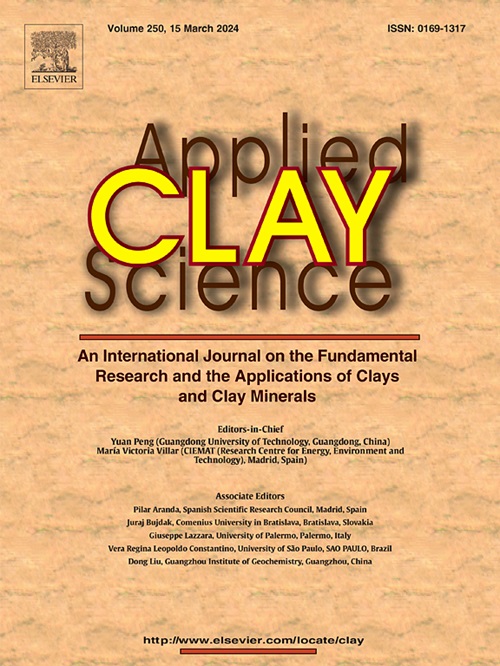Mineralogical and geotechnical characterization of two German bentonites from Westerwald and Bavaria
IF 5.8
2区 地球科学
Q2 CHEMISTRY, PHYSICAL
引用次数: 0
Abstract
This study investigates the fundamental mineralogical, physico-chemical, and geotechnical properties of two naturally occurring Ca/Mg bentonites from Germany, along with their Na-saturated sub-fractions. The bentonites — Secursol UHP® from Westerwald and Calcigel® from Bavaria — are commercially available and used in different forms, including granular and pillow types, for geotechnical purposes and multiscale testing of the Sandwich sealing system for hydraulic sealing in underground waste repositories. The dioctahedral smectite content in Secursol UHP and Calcigel is 79 % and 61 %, respectively. Smectite in both was identified as montmorillonitic beidellite with significant octahedral iron and no interstratification. Smectite in Secursol UHP shows a slightly higher layer charge and broader particle size distribution, while Calcigel smectite has a 25 % larger average basal surface and slightly greater stack thickness. Geotechnically, both are highly plastic clays with almost identical consistency as received; however, Calcigel exhibits a higher liquid limit, greater water uptake, and better dispersity in deionized water despite its lower smectite content, lower total specific surface area, and relatively coarser particles. These discrepancies are attributed to the inherited fabric of Secursol UHP hindering smectite expansion.
威斯特瓦尔德和巴伐利亚两种德国膨润土的矿物学和岩土学特征
本研究调查了德国两种天然Ca/Mg膨润土的基本矿物学、物理化学和岩土力学性质,以及它们的na饱和亚组分。来自Westerwald的Secursol UHP®和来自Bavaria的Calcigel®膨通土已上市,并以不同的形式使用,包括颗粒型和枕型,用于岩土工程目的和用于地下废物库液压密封的Sandwich密封系统的多尺度测试。Secursol UHP和Calcigel的二八面体蒙脱石含量分别为79%和61%。两者中的蒙脱石被鉴定为蒙脱石贝德尔石,具有显著的八面体铁,无层间沉积。Secursol UHP中蒙脱石的层电荷略高,粒径分布更宽,而Calcigel蒙脱石的平均基面大25%,堆积厚度略大。从地质技术上讲,两者都是高塑性粘土,具有几乎相同的稠度;然而,尽管钙铁石的蒙脱石含量较低,总比表面积较低,颗粒相对较粗,但它在去离子水中表现出更高的液限,更大的吸水性和更好的分散性。这些差异是由于Secursol UHP的遗传结构阻碍了蒙脱石的膨胀。
本文章由计算机程序翻译,如有差异,请以英文原文为准。
求助全文
约1分钟内获得全文
求助全文
来源期刊

Applied Clay Science
地学-矿物学
CiteScore
10.30
自引率
10.70%
发文量
289
审稿时长
39 days
期刊介绍:
Applied Clay Science aims to be an international journal attracting high quality scientific papers on clays and clay minerals, including research papers, reviews, and technical notes. The journal covers typical subjects of Fundamental and Applied Clay Science such as:
• Synthesis and purification
• Structural, crystallographic and mineralogical properties of clays and clay minerals
• Thermal properties of clays and clay minerals
• Physico-chemical properties including i) surface and interface properties; ii) thermodynamic properties; iii) mechanical properties
• Interaction with water, with polar and apolar molecules
• Colloidal properties and rheology
• Adsorption, Intercalation, Ionic exchange
• Genesis and deposits of clay minerals
• Geology and geochemistry of clays
• Modification of clays and clay minerals properties by thermal and physical treatments
• Modification by chemical treatments with organic and inorganic molecules(organoclays, pillared clays)
• Modification by biological microorganisms. etc...
 求助内容:
求助内容: 应助结果提醒方式:
应助结果提醒方式:


